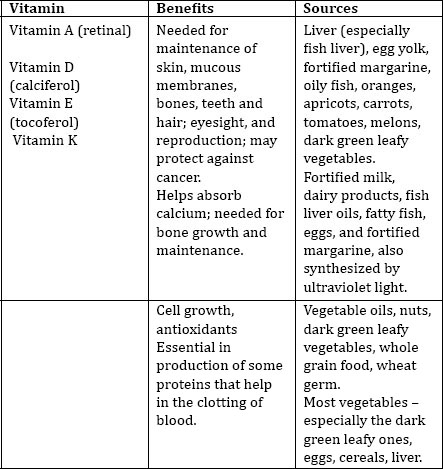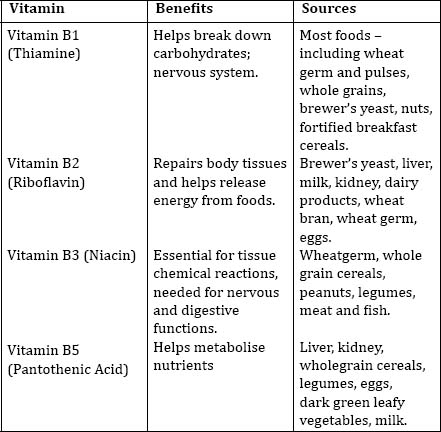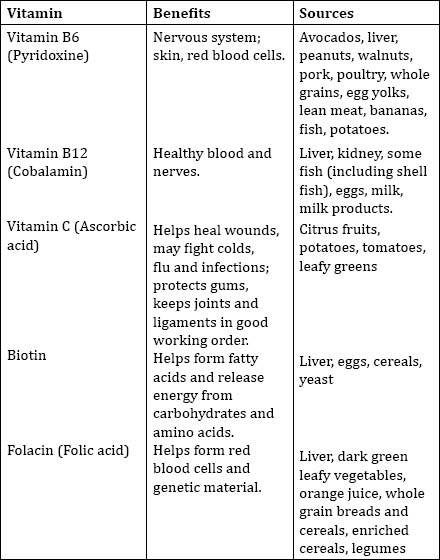

Probably the most well known antioxidant, vitamin C helps minimize free radical damage to the neurological system. In the presence of hesperidin, a bioflavonoid, vitamin C is an even more powerful antioxidant. It also protects other antioxidants in the body, such as vitamin E. In addition to neutralizing free radicals, vitamin C detoxifies the body, reduces high blood pressure, lowers cholesterol, and fights cancer.
Both vitamin A and beta-carotene are powerful free-radical scavengers that help the skin, mucous membranes, circulatory system, and cholesterol levels. In particular, beta-carotene is very effective in neutralizing the singlet oxygen-free radical. More than 600 different types of carotene have been identified from fruits and vegetables, only a few of which have been studied. Preliminary research indicates that alpha-carotene is up to 100 times more powerful as an antioxidant than beta-carotene. Others include lutein, gamma-carotene, zeaxanthin, and lycopene, a known cancer fighter that occurs in high concentrations in tomato products.
This antioxidant prevents the oxidation of lipids (fats) in cell membranes, which strengthens the outer cell layers against free radical attack. Vitamin E works best in the presence of selenium, another antioxidant, and helps protect vitamin A. Vitamin E stimulates the immune system, improves the circulatory system and oxygen absorption, fights cancer, and has a role in preventing cataracts.
Lycopene – There is no question today that antioxidants are a significant part of the important nutrients we need today to support our health. One of the more newly discovered antioxidants is lycopene. This much-hailed phytonutrient is found in tomatoes. It is actually the substance that gives tomatoes their red colour and, like beta-carotene, is a member of the carotenoid family.
Research on dietary lycopene suggests that it may lower the risk of heart attack. A five-year study of 48,000 men found that those eating ten servings per week of cooked tomato products had the lowest risk of prostate cancer. Believe it or not, their risk was only one-third that of men eating less than two servings per week. Other studies suggest that lycopene may play a major role in reducing the risk of other cancers, including cancers of the breast, rectum and colon.
And there’s more. While fresh tomatoes are loaded with lycopene, cooking them makes it even easier for your body to use their lycopene. Apparently, as the tomatoes break down when they are cooked, the lycopene is more easily absorbed. Including a little fat will help, too, especially mono saturated fat like olive oil.
It is not known exactly how much lycopene one should consume each day, but based on recent studies, you would probably want to eat ten servings of tomatoes per week.
When you exercise heavily, you need additional antioxidants according to a leading researcher. Exercise stimulates your body’s production of “free radicals” that attack cells, leading to long-term damage and a higher risk of cancer. To counteract the exercise hazard, experts suggest taking antioxidant supplements daily, notably vitamin E (400 IU) and vitamin C (1000 mg).
Chocolate facts – One scientist recently discovered that chocolate contains phenolics, an antioxidant that is believed to reduce your overall chances of contracting heart disease. Pure chocolate may be the best chocolate around. That’s because the fat in pure chocolate usually comes from cocoa butter and cocoa butter has a high content of stearic acid, the saturated fat that doesn’t hurt your blood cholesterol level. What’s better for you, white or dark chocolate? As a general rule, dark chocolate is made from a higher content of cocoa butter. It also contains many phenolics. White chocolate usually doesn’t have very many phenolics, but is loaded with cocoa butter. A dark chocolate bar is considered the most beneficial, followed by fudge syrup, baking chocolate, chocolate fondue, and semisweet chips.
Coffee cure – Brewed coffee seems to create hundreds of new chemicals that appear to have antioxidant qualities. Each chemical is present in only tiny amounts, but taken together in a cup of coffee, they could add up to have about the same antioxidant effect as three oranges.
Selenium support – Selenium has been found to be beneficial in the fight against free radicals, which contribute to premature ageing, among other things. Selenium is found in the highest concentrations in sea-foods, grains, muscle meats, and Brazil nuts. A multi-vitamin that contains between 70-100 mcg is recommended, but an additional supplement is not necessary. It has been recently shown that selenium can help prevent cancer.
Just like it protects your car from rust, zinc has antioxidant properties that protect the body. Zinc is required to maintain effective levels of vitamins E and A. It is also a key ingredient in the very important antioxidant enzyme called superoxide dismutase (SOD).
Pycnogenol is an effective antioxidant. Common sources are the bark of the French maritime pine tree (Pycnogenol), grape seed, lemon tree bark, peanuts, and cranberries. Research indicates that this compound may be 20-50 times more potent than vitamins C and E. besides; it keeps joints and skin supple, promoting a youthful appearance. It also strengthens capillaries, improves circulation, reduces joint pain, and protects nerve tissue.
Several popular supplements– bilberry, ginkgo biloba, and garlic– are very strong antioxidants. Bilberry helps eliminate free radicals from capillary walls and red blood cells; it is also known to check arthritis. Its ability to improve vision was first observed during World War II when it was discovered that British pilots, who ate bilberry jam, had excellent twilight vision. Ginkgo biloba is famous for improving memory, partly because it contains antioxidants that scavenge free radicals and boost the effectiveness of vitamin C. It also improves circulation, heart conditions, and neurological disorders such as Alzheimer’s disease.
Garlic contains high amounts of antioxidants vitamin A, vitamin C, carotene, and selenium and boosts the levels of antioxidant enzymes in the bloodstream. Green tea also contains a variety of antioxidants, including catechin, and is known to lower cholesterol levels and reduce blood clotting.
Fat soluble vitamins – they are mainly found in oils and fat containing foods. Since the body stores these in its fatty tissues, one does not need to eat them every day. Overdoses can be toxic.

Water-soluble vitamins are found in a variety of plant and animal foods. Because the body stores them in small amounts and quickly excretes excesses, they need to be part of your diet nearly every day.


